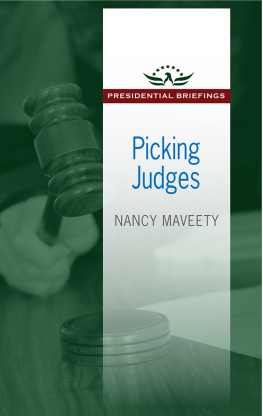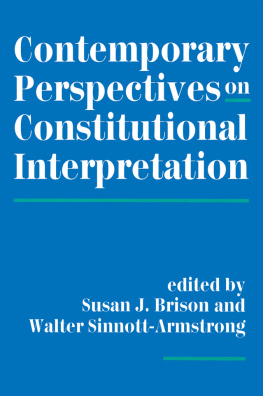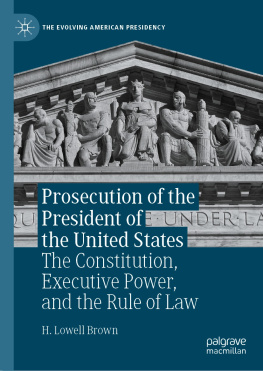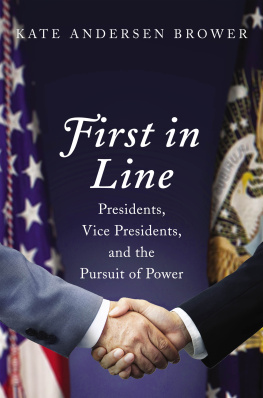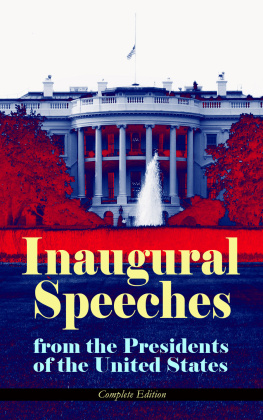


Published with assistance from the Mary Cady Tew Memorial Fund.
Copyright 2012 by Brian C. Kalt.
All rights reserved.
This book may not be reproduced, in whole or in part, including illustrations, in any form (beyond that copying permitted by Sections 107 and 108 of the U.S. Copyright Law and except by reviewers for the public press), without written permission from the publishers.
Yale University Press books may be purchased in quantity for educational, business, or promotional use. For information, please e-mail (U.K. office).
Set in Scala type by IDS Infotech Ltd., Chandigarh, India.
Printed in the United States of America.
Library of Congress Cataloging-in-Publication Data
Kalt, Brian C.
Constitutional cliffhangers: a legal guide for presidents and their enemies/Brian C. Kalt.
p.cm.
Includes bibliographical references and index.
ISBN 978-0-300-12351-7 (hardback)
1. Presidents Legal Status, laws, etc.United States. I. Title.
KF5051.K35 2012
342.73'062dc23
2011022723
A catalogue record for this book is available from the British Library.
This paper meets the requirements of ANSI/NISO Z39.481992 (Permanence of Paper).
10 9 8 7 6 5 4 3 2 1
For Benjamin and Jonathan
CONTENTS
PREFACE
Soon after I started writing this manuscript, I attended a reception for a prominent legal scholar. I was lucky enough to speak with him, and at one point the conversation turned to my work. I was about fifteen seconds into a description of an issue I was working on when he asked, with mild revulsion, Why are you writing about that?
This book deals with a lot of issues of that ilk: weird twists of constitutional law that might seem unlikely to occur. In short, I am regarded by some of my colleagues as, to quote Leo Rosten in The Joys of Yiddish, the kind who worries whether a flea has a pupik [navel].
But I do think that at least one of the six scenarios in this bookor something very similarwill come to pass someday. I also believe that if anything like them does happen, the fact that people thought and wrote about such things beforehand will help to raise the tone of the public debate. (To be useful on such an occasion, I have provided a thicker-than-usual layer of citations and discussion in the endnotes, which I have consolidated into no more than one per paragraph in the main text.) More broadly, I think it is worth pondering why these sorts of pitfalls arise, how to fix them, and why we often don't fix them.
Aside from all this, these scenarios are just very compelling. In addition to their superb dramatic possibilities, they provide an opportunity to think about important and interesting general topics, like presidential immunities, pardons, constitutional procedures, presidential succession, impeachment, term limits, presidential history, constitutional interpretation, and presidential power in general.
So that is why I am writing about this.
ACKNOWLEDGMENTS
Portions of this book have previously appeared in print as law-review articles. Some have been edited, updated, and paraphrased; parts have been used verbatim, without direct quotation or citation. Specifically, Chapter 1 draws heavily upon Akhil Reed Amar & Brian C. Kalt, The Presidential Privilege Against Prosecution, 2 Nexus 11 (1997) (with Professor Amar's gracious permission); Chapter 2 on Brian C. Kalt, Note, Pardon Me?: The Constitutional Case Against Presidential Self-Pardons, 106 Yale L.J. 779 (1996); and Chapter 5 on Brian C. Kalt, The Constitutional Case for the Impeachability of Former Federal Officials: An Analysis of the Law, History, and Practice of Late Impeachment, 6 Tex. Rev. L. & Pol. 13 (2001).
I would like to thank Richard Albert, Akhil Reed Amar, Kristi Bowman, Bruce Boyden, Brady Bustany, Adam Candeub, Sonia Fulop, Michael Gerhardt, Mel Kalt, Sara Kalt, Mae Kuykendall, Michael Lawrence, Gerard Magliocca, Lumen Mulligan, Michael O'Malley, Adam Pavlik, Frank Ravitch, Alice Ristroph, Ronald Rotunda, Glen Staszewski, and Ben Walther for their suggestions. Robert Bennett, Josh Chafetz, Joel Goldstein, Adam Gustafson, and Seth Tillman deserve extra recognition for their particularly thorough comments.
I would also like to thank the people who provided the truly outstanding research support for which Michigan State University College of Law is justly proud: librarians Barbara Bean, Brent Domann, Jane Meland, and Kathy Prince, and students Jon Abent, Jordan Brackey, Nathan Cortright, Christy McDonald, Jason Murdey, and Sarah Pulda. With all the hard work they did on my behalf, I'm even more embarrassed that this book took me as long to write as it did. On that note, I'd like to thank my dean, Joan Howarth, for her patience.
Finally, I must give special thanks to Jorge E. Souss, who contributed more careful scrutiny, helpful comments, and clear thinking than any sensible person would ever have taken the time to produce.
Introduction
Electing, punishing, and replacing presidents can get tense. Ideally, the constitutional rules would be clear on such occasions, but often they are not. This book examines six presidential constitutional cliffhangers: scenarios in which the fate of the president or presidency is in doubt as politicians, courts, and the people argue over the proper interpretation of the Constitution.
The scenarios covered in Chapters 1 through 6, respectively, are:
1. a president is criminally prosecuted;
2. a president pardons himself;
3. cabinet members try to oust an allegedly disabled president, who in turn tries to oust them;
4. with the president and vice president dead, the secretary of state and the Speaker of the House fight for control of the presidency;
5. an ex-president is impeached; and
6. a two-term president attempts to stay in power.
As the title indicates, this book is mainly a legal guide to navigating these six scenarios should they ever occur. In the process, though, these six discussions shed light on how law and politics combine to settle cliffhangers, how the constitutional weak spots that produce cliffhangers can be patched up, why such repairs are nevertheless rare, and how best to prevent these weak spots from forming in the first place. Rather than clutter up the individual legal guides with all this, these insights are distilled and collected in Chapter 7.
First, though, there is an obvious underlying question: why worry about a bunch of odd things that seem so unlikely? One reason is that they let us think more generally about interesting constitutional issues, like immunity, pardons, disability, succession, impeachment, and term limits. The rest of this introduction will offer a more direct reasonthat cliffhangers do happenand will consider what causes these constitutional gaps to arise and persist.
It'll Never Happen (Until It Does)
None of the six scenarios in this book has ever happened. That is why they are in the bookthey are unprecedented, so they present legal uncertainty. But constitutional cliffhangers arise all the time; these are just six that have not arisen yet. Indeed, Scenarios 1 and 2 have happened recently in one sense of the word: prosecutors have considered prosecuting presidents and have had to analyze presidential immunity, and at least one president considered pardoning himself and had his lawyers look into it. Scenarios 5 and 6 have happened in another sense of the word: officials other than the president have been impeached after leaving office, and leaders other than the president have used loopholes to subvert term limits. Moreover, all six of the scenarios have been recognized and seriously discussed at the highest levels of power. This book is not about idle chatter.
Next page





